Renault Samsung Motors
Renault Samsung Motors (Korean: 르노삼성자동차, IPA: [ɾɯnoː sʰamsʰʌŋ dʑadoŋtɕʰa]), also known by its initials RSM, is a South Korean car manufacturer headquartered in Busan where its single assembly site is also located, with additional facilities at Seoul (administration), Giheung (research and development) and Daegu (vehicle testing). It was first established as Samsung Motors in 1994 by the chaebol Samsung, with technical assistance from Nissan. The company started selling cars in 1998, just before South Korea was hit by the Asian financial crisis. In September 2000, it became a subsidiary of the French car manufacturer Renault and adopted its present name, although Samsung maintained a minority ownership.
 | |
Native name | 르노삼성자동차 주식회사 |
|---|---|
| Formerly | Samsung Motors, Inc. |
| Type | Subsidiary |
| Industry | Automotive |
| Founded | 1994[1] |
| Headquarters | Busan, South Korea |
Key people | Dominique Signora (CEO)[2] |
| Products | Cars, luxury cars |
Production output | 215,851 (2018)[3][note 1] |
| Revenue | |
| Total assets | |
| Total equity | |
| Owners |
|
Number of employees | 4,387 (December 2013)[5] |
| Parent | Renault |
| Website | renaultsamsungm.com |
| Renault Samsung Motors | |
| Hangul | 르노삼성자동차 |
|---|---|
| Hanja | 르노三星自動車 |
| Revised Romanization | Reuno Samseong Jadongcha |
| McCune–Reischauer | Rŭno Samsŏng Chadongch'a |
RSM markets a range of cars, including electric models and crossovers.
History
Beginnings: Samsung Group era (1994–2000)
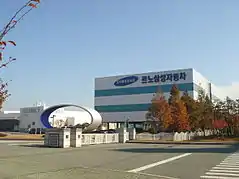
In the early 1990s, Samsung's Chairman Lee Kun-hee recognised the automotive industry as the culmination of several others. For the Samsung Group, this would allow to leverage resources and technologies from the entire group including Samsung Electrics and Samsung Electronics.[6] He initially tried to take control of Kia, but competition from other bidders and legal restrictions led to him dropping the idea. Kia was eventually purchased by Hyundai.[7]
Lee decided to create a new carmaker, Samsung Motors (also known as SMI)[8] and a truck manufacturer, Samsung Commercial Vehicles Co., Ltd. (Korean: 삼성상용차 주식회사; RR: Samseong Sangyongcha Jusikoesa), the latter through Samsung Heavy Industries with Nissan Diesel's support.[9][10] SMI was established in 1994 (incorporated in 1995)[8] and Daegu-based Samsung Commercial Vehicles in 1996.[10][11][12] Shortly after SMI started its operations, the Asian financial crisis hit.[8][13] Samsung divested itself of SMI as well as other non-core subsidiaries.[14] SMI was put up for sale, with Daewoo Motors being one of the first interested companies,[7][15] but, as the crisis deepened, Daewoo Motors itself was bought by GM.[16] Hyundai Motors was also considered as a possible buyer, but corporate politics and strife between the Samsung Group and the Hyundai Group made this impossible. Negotiations with Renault started in December 1998, and in September 2000 the French automaker bought a 70% stake for US$560 million .[13][17] Samsung Commercial Vehicles was kept by Samsung, but finally it filed for bankruptcy at the end of 2000.[12][14]
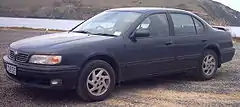
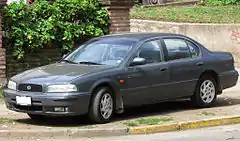
Coupled with his interest on cars, Lee's project of building SMI as a global automotive company started out with technical assistance from Nissan,[15] a company which at the time of SMI's early stages was in dire financial straits. SMI's affiliation with Nissan could have been one of the reasons for Renault buying a major share of the company, as Renault had become a major shareholder of Nissan by then. One of the very early planners for SMI has stated that technical affiliations for SMI were initially considered with Volkswagen, BMW or Honda.[18] From 1998, Renault Samsung Motors sold cars in Chile with the introduction of the SQ5 (the current SM5).[19]
Product and market expansion (2000–2010)
After the 2000 acquisition, Renault renamed Samsung Motors as Renault Samsung Motors (RSM).[20] That year, the company's sales began to improve. Journalists attribute this to the success of the first car manufactured at Busan in taxi fleets (the SM5), which led to increased confidence of the model within the rest of their customer base.[13][21] During the following years, the company introduced a new vehicle range, including the SM3 in 2002, the SM7 in 2004 and the crossover QM5 in 2007. Over time, RSM changed its products from a Nissan-based architecture to a Renault-based one.[20] As part of the Renault group, Renault Samsung became an export-oriented manufacturer.[21]
In 2005, Renault increased its stake by acquiring an additional 10% share from the company's creditors.[22][23] On 26 June 2009, Renault and Samsung agreed to renew the right of the former to use the "Samsung" trade mark on its products until 2020.[24][25]
Decline in sales, electric vehicles and recovery attempts (2010–present)
The pressure from both Hyundai and Kia, dominant automakers in the South Korean market, increased during the 2010s, pushing RSM sales down by 27% in 2011. In the first half of 2012, they fell 41%.[26] In August 2012, a personnel reduction of about 80% of employees was presented by management.[27] Finally, Renault reduced its Busan personnel by 15% (about 800 employees). With the aim of reviving the company, it invested (together with Nissan) US$160 million to make Nissan Rogues for export in order to improve the production output[28] and also presented revised versions of the SM3 and SM5.[26][29] During 2013, the company started to market a new compact crossover, the QM3, based on the Captur.[30][31] By late 2015, its cumulative sales since 2000 in the South Korean market reached 1.5 million units.[32] In 2016, Renault Samsung introduced the SM6, a new mid-size model which is a Talisman with some minor changes for the South Korean market,[33] and the crossover QM6.[34] In 2018, the company introduced the Clio [35] and the Master.[36] By 2019, production and sales were again declining,[37] and the company announced an extension of its contract with Nissan for continuing the assembly of Nissan Rogues until March 2020, although in a reduced capacity, in order to secure production volume.[37][38] RSM also announced plans to gain more production orders from parent Renault. Tensions with labour increased, as the company started an early retirement plan aimed at reducing the workforce.[37] During 2019, Renault Samsung discontinued most of its saloon models to focus on crossover SUVs. In June 2019, the company ended production of the SM5. At the end of the year, the internal combustion engined-SM3 and the SM7 were also put out of production, with sales ending by January 2020.[39] In March 2020, the company put on sale the XM3 crossover.[40]
In 2012, RSM introduced an electric version of its SM3 car known as the SM3 Z.E., imported from Turkey. In October 2013 the car started to be assembled at the Busan plant[41] and in the same year it became the leading electric vehicle by sales in South Korea with a 58% market share.[42] In 2016, RSM also announced its intention to market the Twizy[43] which was launched in 2017.[35] In May 2016, the company announced a project to develop and produce a 1-tonne electric light commercial vehicle with a 250-kilometre range on a single charge in partnership with local companies.[44]
As of 2013, Chile was the only country outside South Korea that RSM has sold its cars under the Renault Samsung Motors marque and not as rebadged Renaults.[45] In 2015, Renault Samsung badging was replaced entirely by Renault in Chile,[46] with the vehicles themselves now being known under their global Renault names (e.g. the Renault Samsung SM5 is the Renault Latitude).
On 19 February 2020, the company announced that RSM will debut at the 2020 Manila International Auto Show on 2 April 2020 with the QM6 and SM6 as the first models to be sold throughout the Philippines.[47][48] The vehicles would be under Legado Motors.[48] As of May 2020, it's postponed due to the COVID-19 pandemic.[49]
On 17 July 2020, RSM issued a statement to deny any plans to change the current company logo to the Renault diamond version in case the Samsung Motors name is dropped since the trademark is due to expire on 4 August 2020.[50]
Facilities
Manufacturing
The car manufacturing plant is located at Busan in the Sinho Regional Industrial Site and began production in 1998.[51] It covers 1,650,000 m2[52] and has the capacity to manufacture 300,000 cars per year. It can produce various models simultaneously in a single production line.[53] The plant is divided into seven production shops (stamping, body, painting, bumper, assembly, al-casting and engine).[52]
Research and development
The Renault Samsung Technical Centre (Korean: 르노삼성 중앙연구소; RR: Reuno Samseong Jungang Yeonguso) located at Giheung near Seoul, is one of the largest research and development facilities of Renault after Guyancourt's Technocentre.[53] It was established in 1997 as the Samsung Motors Technical Centre,[54] being expanded in 2000 and adopting its current name.[54][55] At first it was only involved in car engineering, but at the end of 2002 the RSM Design Centre (Korean: 르노삼성자 디자인센터; RR: Reuno Samseongja Dijain Senteo) was created within the facility to locally design various cars manufactured by the company.[54][56] In early 2013 the design branch was renamed Renault Design Asia (Korean: 르노 디자인 아시아; RR: Reuno Dijain Asia) and was put in charge of supervising Renault's Asian design operations.[57]
In November 2018, the company opened a vehicle testing centre in Daegu for vehicles aimed at the Asia-Pacific market, in partnership with the city government and Korea Intelligent Automobile Parts Promotion. The facility can test electric, autonomous and connected vehicles[58]
Administration
From 1995 until 2013, the company's head offices were at the HSBC Building in Jung-gu, Seoul.[59] In January 2013, it moved them to a purposely-built facility, the RSM Tower (Korean: RSM 타워; RR: RSM Tawo) in Gasan-dong,[59][60] Seoul. In December 2017, RSM moved most management functions to a building in Yeoksam-dong, Seoul, although kept some offices and car maintenance activities at floors of the RSM Tower.[60]
There are additional administrative offices in Busan.[53]
Branding

Logos
Renault Samsung Motors has two logos: the corporate logo and the marque logo.[61][62] The first is for corporate communications and is an adaptation of the Samsung Group's logo.[61][62][63] The second is the "storm's eye" logo which is used as marque's badge and in advertising.[64] The imported models introduced from 2017 onwards in South Korea kept Renault's diamond badge instead of being rebadged with the Renault Samsung logo.[35]
Slogan
The advertising slogan of Renault Samsung Motors is Discover the Difference (Korean: 디스커버 더 디퍼런스; RR: Diseukeobeo Deo Dipeoreonseu)[65][66] and was introduced in 2009. According to the company, it refers to the distinct quality of its products.[66]
Vehicle nomenclature
The company includes in its vehicles' designations numbers related to their sizes. Those numbers are 3, meaning compact or small vehicle, 5 and 6,[33] mid-size vehicle, and 7, large vehicle.[67][68] The designations also include the letters S and M, which stands for Samsung Motors[67] and Samsung Motor Sedan.[68][69] However, the sport utility vehicles replace the SM combination by QM (Quest Motoring).[68][70] The imported models introduced from 2017 onwards in South Korea kept their original names instead of adopting RSM's nomenclature.[35] In March 2020, the company introduced the XM nomenclature for a locally produced crossover SUV.[40]
Typography
In 2016, Sandoll Communications, Inc. built a Hangul version of Renault's Renault Life font family for the company. It consists of three fonts in three weights (light, regular, bold) and one width in Roman only. The font was designed by Park Ju-seong and Wi Ye-jin, under the direction of Lee Do-kyung.[71]
Solar energy project
In March 2013, Renault Samsung Motors completed the installation of solar panels in the parking lots, rooftops and surrounding land of its Busan facility to create a 20-MW solar plant, one of the largest in the world. The project was carried out through a joint venture, Busan Shinho Solar Power SPC (Korean: 부산신호태양광 특수목적법인; RR: Busan Sinho Taeyang-gwang Teugsumogjeogbeob-in), formed by RSM, Korea East-West Power and KC Cottrell, which also manages the plant. It provides energy to the RSM operations and nearby houses.[72][73]
Shareholders
Renault Samsung Motors is majority owned by Renault with an 80.1% share. Samsung Card has a 19.9% share of the company.[74]
Model lineup
As of November 2020 the model lineup consists of the following vehicles:[75][76][77]
Renault Samsung
- SM3 Z.E. (small electric car based on the Renault Fluence Z.E.)
- SM6 (large four-door car based on the Renault Talisman)[33]
- QM6 (the second crossover for the company, based on the second-generation Renault Koleos)
- XM3 (a crossover based on the Renault Arkana)
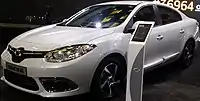 Renault Samsung SM3 Z.E.
Renault Samsung SM3 Z.E.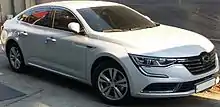 Renault Samsung SM6
Renault Samsung SM6 Renault Samsung QM6
Renault Samsung QM6.jpg.webp) Renault Samsung XM3
Renault Samsung XM3
Notes
- Vehicles badged as Renault Samsung, Renault and Nissan.
References
- Tilley, Aaron (28 August 2015). "Samsung amasses largest patent war chest among tech giants for cars of the future". Forbes. Retrieved 16 March 2016.
- Jhoo, Dong-chan (1 November 2017). "Renault Samsung appoints new CEO". The Korea Times. Retrieved 15 March 2018.
- "Facts and figures 2018" (PDF). Renault. p. 10. Retrieved 10 November 2019.
- "르노삼성자동차(주)" [Renault Samsung Motors (Co.)]. Catch (in Korean). Retrieved 14 November 2019.
- "2013 Registration Document" (PDF). Renault. pp. 14, 23. Archived from the original (PDF) on 8 April 2014. Retrieved 8 April 2014.
- Lee, Woonghee; Lee, Nam S. (2007). "Understanding Samsung's Diversification Strategy: The Case of Samsung Motors Inc" (PDF). Long Range Planning. Oxford: Elsevier. 40 (4–5): 496. doi:10.1016/j.lrp.2007.06.011. ISSN 0024-6301. Archived from the original (PDF) on 28 February 2013.
- Wad, Peter (2002). "The political business of development in South Korea". In Gómez, Edmund Terence (ed.). Political Business in East Asia. Routledge. p. 194. ISBN 0-415-27149-5.
- Thomsom, Neil; Baden-Fuller, Charles (2010). Basic Strategy in Context: European text and cases. John Wiley & Sons. p. 155. ISBN 978-1-4051-6108-4.
- "Company News: Samsung Planning commercial vehicle venture". The New York Times. 13 June 1992. Retrieved 19 March 2013.
- 삼성상용차 24일 파산 신청 [Samsung Commercial Vehicles for bankruptcy in 24 days]. article.joins.com (in Korean). JoongAng Ilbo. 23 February 2002. Archived from the original on 24 August 2013. Retrieved 24 August 2013.
- "History". Samsung. Archived from the original on 2 July 2012. Retrieved 19 March 2013.
- "Samsung Commercial Vehicle Applies for Bankruptcy". The Chosun Ilbo. 24 November 2000. Retrieved 19 March 2013.
- "Renault Samsung: A French Recipe to Savor". Bloomberg BusinessWeek. 6 October 2002. Retrieved 4 November 2012.
- Michell, Anthony (2010). "Samsung Electronics and the Samsung Group". Samsung Electronics and the Struggle For Leadership of the Electronics Industry. John Wiley & Sons. pp. 57–58. ISBN 978-0-470-82266-1.
- "The short, troubled life of Samsung Motors?". wardsauto.com. Ward's. 1 January 1999. Archived from the original on 10 March 2013. Retrieved 9 March 2013.
- Tiberghien, Yves (2007). "The Transformation of the Automobile Industry". Entrepreneurial States: Reforming Corporate Governance in France, Japan, and Korea. Cornell University Press. p. 199. ISBN 978-0-8014-4593-4.
- "BUSINESS | Renault takes over Samsung". BBC News. 25 April 2000. Retrieved 12 October 2012.
- 삼성차 몰락의 드라마 [Samsung Motors' dramatic downfall]. Dong-a Ilbo Magazine (in Korean). Retrieved 19 March 2013.
- "Renault Samsung Motors cumple 10 años en Chile" [Renault Samsung Motors celebrates 10 years in Chile]. terra.cl (in Spanish). Terra. 8 July 2008. Archived from the original on 29 September 2013. Retrieved 9 March 2013.
- "Renault Samsung Motors background". Renault. Archived from the original on 29 October 2013. Retrieved 17 March 2014.
- Ahn, Seok Hyeon (6 November 2013). 갯벌위에 지어진 르노삼성, 위기를 돌파할 두 번째 열쇠는? [Renault Samsung: built over tidal. The second key is to break through the crisis ?]. The Chosun Ilbo (in Korean). Archived from the original on 18 March 2014. Retrieved 7 November 2013.
- "Renault compra 10% Samsung por 45 millones euros" [Renault purchases 10% of Samsung for €45 million]. hoy.com.do (in Spanish). Hoy. 29 December 2005. Retrieved 31 October 2013.
- "Renault Increases Stake in Samsung Motors to 80%". Greencarcongress.com. 29 December 2005. Retrieved 31 October 2013.
- "Renault, Samsung, renew trademark deal". Just-auto.com. 26 June 2009. Retrieved 17 March 2014.
- "PRESS DIGEST – South Korean newspapers – June 26". Reuters. 26 June 2009. Archived from the original on 17 March 2014. Retrieved 17 March 2014.
- "Job Cuts at Renault Samsung Motors Could Hit 80% of Staff". Industryweek.com. 10 August 2012. Retrieved 9 September 2012.
- "Renault Samsung : un plan de départ pour 80% des salariés".
- Lee, Ji-yoon (26 September 2014). "Renault Samsung Motors starts Nissan Rogue shipments to U.S." The Korea Herald. Retrieved 27 September 2014.
- "Renault Samsung: About 800 employees opt to retire". marketswatch.com. MarketWatch. 9 September 2012. Retrieved 9 September 2012.
- "Renault Samsung's New Crossover Captur Named "GM3"". Korea Economic Daily. 18 February 2013. Retrieved 21 March 2013.
- "Renault Samsung Motors to begin early QM3 sales". The Korea Herald. 14 November 2013. Retrieved 20 November 2013.
- "Renault Samsung's cumulative sales in S. Korea top 1.5 mln units". english.yonhapnews.co.kr. Yonhap News. 16 November 2015. Retrieved 16 November 2015.
- Choi, Jin-seok (18 January 2016). "르노삼성 SM6 등장, SM5의 운명은?" [Renault Samsung SM6 appeared, what the fate of the SM5 is?]. Korea Economic Daily (in Korean). Archived from the original on 10 February 2016. Retrieved 3 February 2016.
- Jhoo, Dong-chan (2 June 2016). "Green cars receive attention in Busan International Motor Show". The Korea Times. Retrieved 10 May 2018.
- Jhoo, Dong-chan (10 May 2018). "Renault Samsung to remove 'Samsung' from its brand name". The Korea Times. Retrieved 10 May 2018.
- "Renault Samsung aims to win 10 pct of light commercial car market by 2020". Yonhap News Agency. 16 October 2018. Retrieved 19 October 2018.
- Kim, Jee-hee (27 August 2019). "Renault Samsung may have to cut workforce". joins.com. JoongAng Ilbo. Retrieved 8 September 2019.
- Jung, Min-hee (28 August 2019). "Renault Samsung to Produce Nissan Rogue until Next March". businesskorea.co.kr. Business Korea. Retrieved 8 September 2019.
- "르노삼성 'SM 3·5·7' 단종…'XM3·캡처·QM6' SUV 라인업으로 빈자리 채운다" [Renault Samsung's SM3, SM5 and SM7 discontinued… XM3, Captur, QM6 SUVs lineup to fill the gap]. ETnews.com (in Korean). 9 January 2020. Retrieved 16 January 2020.
- Jo, He-rim (9 March 2020). "Renault Samsung launches XM3, 8,542 units presold". The Korea Herald. Retrieved 18 March 2020.
- "Renault Samsung Starts Mass-production of Electric Vehicle SM3 Z.E." Korea Economic Daily. 7 October 2013. Retrieved 6 November 2013.
- "Renault Samsung aims to raise EV market share to 60 pct in 2014". english.yonhapnews.co.kr. Yonhap News. 14 March 2014. Retrieved 17 March 2014.
- "Renault Samsung to introduce Twizy ultra-small electric car in Korea". english.yonhapnews.co.kr. Yonhap News. 18 May 2016. Retrieved 2 June 2016.
- Jung, Min-hee (18 May 2016). "Renault Samsung to develop world's first electric light commercial vehicle". businesskorea.co.kr. Business Korea. Retrieved 2 June 2016.
- "Renault Atlas March 2013" (PDF). Renault. Retrieved 5 March 2013.
- "Archived copy". Archived from the original on 14 August 2009. Retrieved 8 January 2015.CS1 maint: archived copy as title (link)
- https://motioncars.inquirer.net/65191/renault-samsung-poised-to-enter-ph-market
- https://visor.ph/industry/south-koreas-renault-samsung-motors-is-coming-to-ph/
- https://www.autodeal.com.ph/articles/car-news-philippines/2020-manila-international-auto-show-has-been-postponed
- https://pulsenews.co.kr/view.php?sc=30800028&year=2020&no=734123
- "Busan – RSM". Renault. Retrieved 19 August 2013.
- "Environmental Statement of Busan Plant" (PDF). Renault. Retrieved 19 August 2013.
- Bursa, Mark (20 September 2010). "Renault's really useful factory". Just-auto.com. Retrieved 2 August 2013.
- 르노삼성자동차 중앙연구소 [Renault Samsung Motors R & D Centre]. The Chosun Ilbo (in Korean). Retrieved 18 August 2013.
- Jo, Young-sin (27 September 2007). '명차 공작소' 르노삼성 기흥 중앙연구소에 가다 ["Best car workplace" goes to Renault Samsung's Giheung R&D facility]. fnnews.com (in Korean). The Financial News. Retrieved 3 August 2013.
- Diem, William (20 November 2002). "Renault Samsung New Design Studio's First Project: Small Car". wardsauto.com. Ward's. Archived from the original on 18 October 2013. Retrieved 2 August 2013.
- Kim, Tae-jong (18 April 2013). "RSM to lead design projects in Asia". The Korea Times. Retrieved 2 August 2013.
- "Renault opens vehicle test center in S. Korea". english.yonhapnews.co.kr. Yonhap News. 23 November 2018. Retrieved 21 December 2018.
- 르노삼성 새 사옥 이전…재도약 계기 마련할까 [Renault Samsung relocates to new offices. Will it have a chance to resurge?]. Daily Sports (in Korean). 23 January 2013. Archived from the original on 31 December 2018. Retrieved 1 January 2019.
- 르노삼성 '강남시대' [Renault Samsung 'Gangnam era']. Seoul Economy (in Korean). 17 December 2017. Retrieved 1 January 2019.
- "CI" (in Korean). Renault Samsung Motors. Archived from the original on 11 November 2013. Retrieved 11 November 2013.
- 자동차회사 [Car companies]. blog.naver.com (in Korean). Naver. 4 March 2005. Retrieved 24 March 2013.
- Kim, Kwang-Suk (2008). "The State—Business Symbiosis in Korea's IT Project: A Final Flowering of the Development State". The Political Economy of Networked Mobility: The Historical Development of the Korean Information Infrastructure, 1995–2005. p. 153. ISBN 978-0-549-73977-7.
- 자동차로고에 담긴 의미 [The meaning of cars' logos]. Korea Economic Daily (in Korean). 31 March 2008. Archived from the original on 11 November 2013. Retrieved 21 March 2013.
- Lewis, Tony (15 September 2010). "Renault plays to Samsung's strength". Just-auto.com. Retrieved 20 August 2013.
- Kwon, Yeok-chang (24 November 2009). 르노삼성, 새 브랜드 슬로건 발표 [Renault Samsung announced a new brand slogan]. Hankook Ilbo (in Korean). Archived from the original on 21 August 2013. Retrieved 20 August 2013.
- Yun, Jeong-Sik (19 November 2009). 엉덩이 숫자는 무슨 의미? [What back numbers means?]. heraldk.com (in Korean). Korea Herald Business. Archived from the original on 19 August 2013. Retrieved 18 August 2013.
- Kim, Hye-won (10 August 2012). "[Brand story] 한국GM & 르노삼성 & 쌍용" [Brand story. GM Korea, Renault Samsung and SsangYong] (in Korean). Theiauto.com. Archived from the original on 23 March 2014. Retrieved 23 March 2014.
- Choi, Hye-lan (2005). "자동차 이름, 앗! 그런 뜻이" [Car name. Ah! Means that.]. Patent 21. Korea Institute of Patent Information. 64 (12): 48. Archived from the original on 29 August 2013. Retrieved 27 August 2013.
- "르노삼성 QM5 디젤 4WD LE A/T" [Renault Samsung QM5 diesel 4WD LE A / T] (in Korean). Megaauto.com. Archived from the original on 18 August 2013. Retrieved 18 August 2013.
- 르노삼성자동차 전용서체 [Renault Samsung Motors font] (in Korean). Sandoll Communications. Retrieved 29 July 2016.
- Courtenay, Vince (12 July 2012). "Renault Samsung Plugs in to Large-Scale Solar Power". wardsauto.com. Ward's. Archived from the original on 18 October 2013. Retrieved 22 March 2013.
- "르노삼성차 부산공장 태양광발전소 가동" [The Solar Power Plant of Renault Samsung Motors' Busan factory is operational]. fnnews.com. The Financial News. 18 March 2013. Retrieved 22 March 2013.
- Lee, Jae-won (27 September 2012). "르노 부회장, "르노삼성 매각 없다"" [Renault Vice President: "Renault Samsung is not for sale"]. The Chosun Ilbo. Retrieved 16 March 2016.
- "Renault Samsung Motors vehicles". Renault. Retrieved 10 May 2018.
- 전체 모델 라인업 [Full model lineup] (in Korean). Renault Samsung Motors. Retrieved 18 March 2020.
- "Renault Brand Homepage". Renault Korea. Retrieved 21 December 2019.
- Herald, The Korea (13 May 2020). "Renault Samsung launches compact SUV Captur in Korea". The Korea Herald. Retrieved 28 May 2020.
External links
| Wikimedia Commons has media related to Renault Samsung Motors. |
- Renault Samsung Motors Homepage (in Korean)